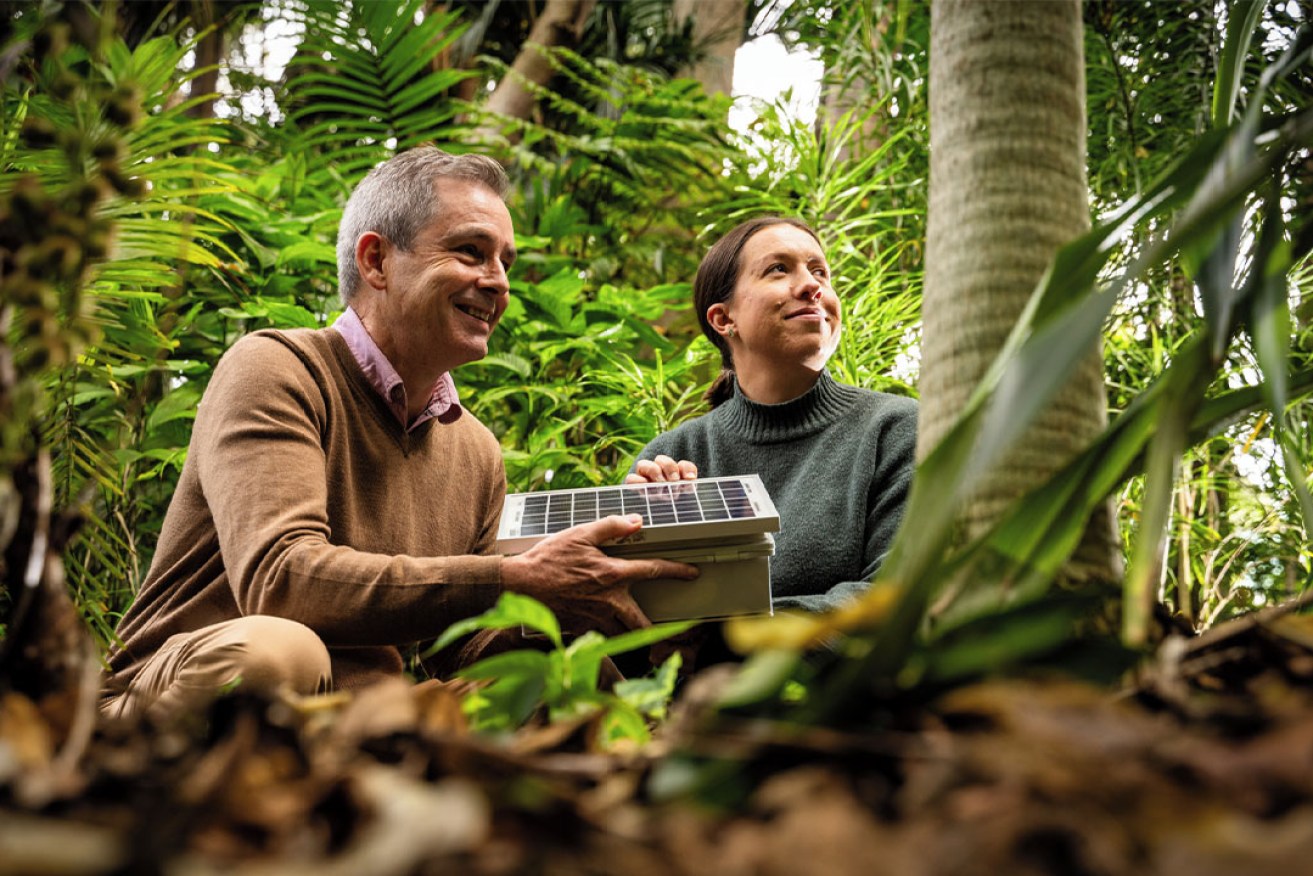Scientists hail AI breakthrough that might stop us saying bye-bye birdie
An ecologist and a computer scientist are teaming up to monitor and save Australian wildlife using AI.

Professor Paul Roe and Dr Daniella Teixeira in the field. (Photo: Tony Phillips).
Birds of a feather are flocking together at QUT where Professor Paul Roe – Head of QUT’s School of Computer Science and the Lead Researcher at the Australian Acoustics Observatory – and Dr Daniella Teixeira – ecologist, and Research Fellow at QUT – are working together with Google Australia to develop an AI that will help scientists identify and monitor bird species.
The project is currently focussed on the threatened Glossy Black Cockatoo but the two hope in time they will be able to extend their work to include other wildlife, like koalas, and invasive species such as cane toads, Asian house geckos and Indian Myna birds.
Recently featured in David Attenborough Netflix film Breaking Boundaries: The Science of Our Planet (2021), Dr Teixeira completed her PHD in 2016 using bioacoustics to to monitor black-cockatoos, in particular the Kangaroo Island glossy black-cockatoo and south-eastern red-tailed black-cockatoo.
“The bushfires of 2019-2020 impacted a lot of the habitat of the glossies in Queensland, NSW, Victoria and Kangaroo Island,” Dr Teixeira said.
“When I finished my PhD, I turned my attention to glossies in Queensland because they don’t get as much attention here. We… put sound recorders in locations across south-east Queensland to monitor the glossies. I was already working with Paul and his team.”
Dr Teixeira explained the model automatically separates, enhances, and isolates the sounds of the Glossy Black Cockatoos, filtering other noise like wind or insects, even picking up very faint calls that could be missed by more traditional methods of identification.
Professor Paul Roe took a more circuitous route to the project, completing a Master of Engineering at the University of York, and obtaining his PhD in Philosophy at the University of Glasgow before arriving at QUT in 1993.
“I am interested in making ecology a big data science,” said Roe. “I want to scale environmental observation by working on the whole problem and not just one aspect or another. For terrestrial fauna, acoustics is really the only way for scale monitoring; the only way we can ‘listen’ to the Australian bush. Through the Australian Acoustic Observatory, we can then store, manage, and analyse those sounds. ”
Since 2019 the Australian Acoustic Observatory, or A20, has captured more than 17 million hours of raw audio, collected through a national network of recorders.
“After [the A20 project] was set up, the ABC contacted me for its Hoot Detectives series to look for owls as a citizen scientist project. The team from Google saw this and got in touch with me and it has grown from there,” said Roe.
Having seen how AI was being used in areas like astronomy, Roe was excited by the possibilities it presented for other sciences.
“I realised AI could revolutionise how we monitor fauna,” he said.
Working as part of Google Australia’s Digital Future Initiative, Roe and Teixeira have developed A20 Search, an AI-powered search engine for matching animal recordings across the Australian Acoustic Observatory’s vast database
A20 Search will be open sourced to the broader research community, enabling nonprofits, universities, and governments to search millions of hours of audio from the Australian Acoustics Observatory, upload audio recordings of a species to find similar sounds across the database, filter by location and date, and download results for other systems.
Roe called A20 Search a huge leap in environmental monitoring.
“In A20 Search we have built a search tool to liberate the data collected in the field. Instead of trying to manually sift through what amounts to hundreds of years of data that we could not live long enough to go through, AI does it for us,” he said.
“ Partnering with Google Australia allows us to share this technology with other scientists and researchers, which in turn will help land managers make informed decisions about conservation, management, and biodiversity protection.”
“Australia’s natural ecosystems are under threat due to the rise of invasive species, climate change, expanding human development, deforestation, bush fires, and many other factors,” said Dr Teixeira.
“As a nation, we have a responsibility to understand how our species and environments are impacted, and what else we can do to protect them. Birds are often considered indicators of ecosystem condition because many species respond to changes in the environment.”
“We need to understand the environment so we can protect it. Bringing ecology and computer science together is the key,” said Roe.












